👁 Yoon Hye Jin | 시린 눈의 옆면 Brim of Misty Eyes
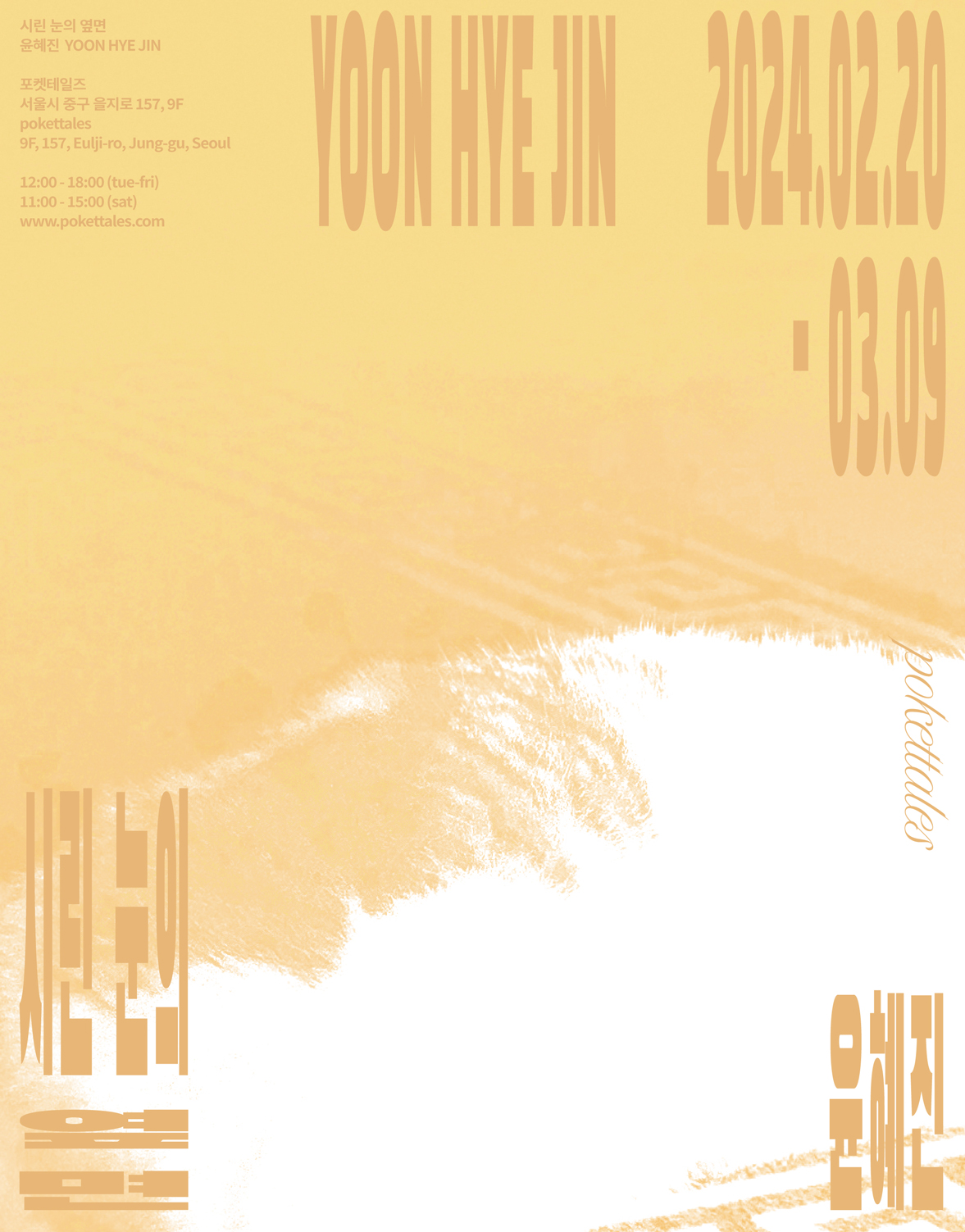
흐린 눈으로 바라보기
선명하게 바라보고 싶은 대상을 코를 박듯 가까이, 더 가까이 들여다본다. 반면 어느 날은 선택적으로 흐린 눈을 한다. 시력의 좋고 나쁨을 떠나 주관적인 감상으로 접어들 때 우리의 시각은 필터를 끼운다. 마치 안과에서 시력 검사를 할 때 렌즈를 끼우며 초점을 맞추는 것처럼 흐렸다가 선명해졌다가 하는 눈앞의 숫자들이 떠오른다.
마음속에 정면으로 마주하기 어려운 대상일수록 좌우 화각의 끄트머리에 한 꼬집씩 만을 인지하며 가늠한다. 그 감정을 개인적으로 대유 하자면 부끄러움, 공포, 슬픔 등이 있다. 윤혜진 작가의 시린 눈의 옆면은 우리의 화각 가장자리의 이미지들과 유사하다. 앞을 바라보고 있지만 또렷하지 않은 옆부분의 상.
때로는 끄집어 내기 두려운 얼굴 대신 그와 관련된 인상들을 암호처럼 부유하는 것으로 기억을 대체한다. 이러한 습관도 반복되면 마치 닳아 없어지듯 느낌만 존재하게 된다. 색으로 뭉쳐진 덩어리, 공기, 향으로 단순해진다. 작가의 추상적인 형태의 창작은 이러한 지점과 맥락을 같이 한다.
매일 같이 저녁이면 렌즈를 빼고 안경을 끼기 전 뿌연 색 면들로 이루어진 풍경을 본다. 가깝고 멀거나 중요하거나 중요하지 않거나 구분 없이 동등한 자리매김을 하고 있다. 그 순간만큼은 다른 시공간의 세계에 머무는 듯한 틈 속에 있는 것 같다. 식별할 수 없는 정보로 이루어진 암호와 같은 풍경 너머에 작가가 숨겨 놓은 대상을 우리는 보지 못한다. 앞서 언급한 그 틈에 우리는 서 있는 것이다. 어떤 사연이 있는지 어떤 감정이 깃든 것인지 속속들이 알길은 없으나 그 풍경은 회화라는 조형적인 아름다움으로 우리 앞에 놓여 있다. 존재했던, 영원히 존재하게 하고 싶은 대상을 흐린 눈으로 바라본 풍경으로 작가는 이를 남긴다. 마치 슬픈 전설이 숨겨진 보석처럼.
작가에게 풍경이란 가장 사적인 공간이면서 누구든 들어올 수 있는 세계로 만드는 과정이다. 시린 눈으로 바라본 풍경은 덤덤하지만 흐릿한 향수를 품고 있다. 조형을 빗기 위해선 호출한 기억들이 씨앗이 되고 그것이 자라나 생긴 수풀은 풍경이 된다. 숨겨진 대상 너머 지면 위 풍경은 우리에겐 공원이 된다. 누구든 들어올 수 있고 자유롭게 거닐 수 있다. 처음 본 길목에서 어색함도 잠시, 언젠가 가보았던가 싶은 풍경도 있고 미래에 볼 것만 같은 풍경도 있다.
Gazing through misty eyes.
We gently focus on the objects we wish to see clearly, drawing nearer, almost as if leaning in, to peer more closely. Yet, on certain days, we deliberately soften our gaze. Regardless of our eyesight, when we go into subjective appreciation, we deliberately put a filter through our lenses. Just like during an eye examination, where the numbers softly blur and then gradually come into focus.
As we confront things that are difficult to face directly, we only catch glimpses of them out of the corner of our eye. If I were to relate these emotions to my own experiences, they might include feelings of shame, fear, sadness, and more. Hyejin Yoon's <Brim of Misty Eyes> reflects the hazy images we see at the edges of our vision. It's an image that remains vague even when looked at directly.
Sometimes, instead of facing something we're afraid to bring up, we replace it with impressions flying around like encrypted codes in our memories. As this habit repeats, it can feel like the actual memory fades away, leaving only a sensation behind. It simplifies into clumps of color, air, and scent. The artist's creation of abstract forms aligns with these points.
Every evening, before I switch from contact lenses to glasses, I see a landscape made of blurry colors. It doesn't matter if things are close or far, important or not; they all hold an equal place. At that moment, it feels like I'm in a gap of a different time and space. Beyond this landscape full of unidentifiable codes, lies what the artist has hidden from us. We stand in that gap mentioned earlier. We may not know the backstory or the emotions hiding within, but the landscape is presented before us as a sculpted beauty of painting. The artist immortalizes the subject, through landscapes seen by blurry eyes, just like a treasure with a sad myth.
For artist Hyejin Yoon, creating landscapes is about turning them into the most personal yet welcoming places for everyone. Looking at landscapes with a misty gaze may seem indifferent, but they hold a vague sense of nostalgia. Memories become seeds that grow into bushes when painted, forming the landscape. Beyond what's hidden, the landscape becomes a park for us, where anyone can come and freely wander. In those unfamiliar landscapes, awkwardness soon fades, and they begin to feel familiar, as if somewhere we wanted to go or destined to visit in the future.


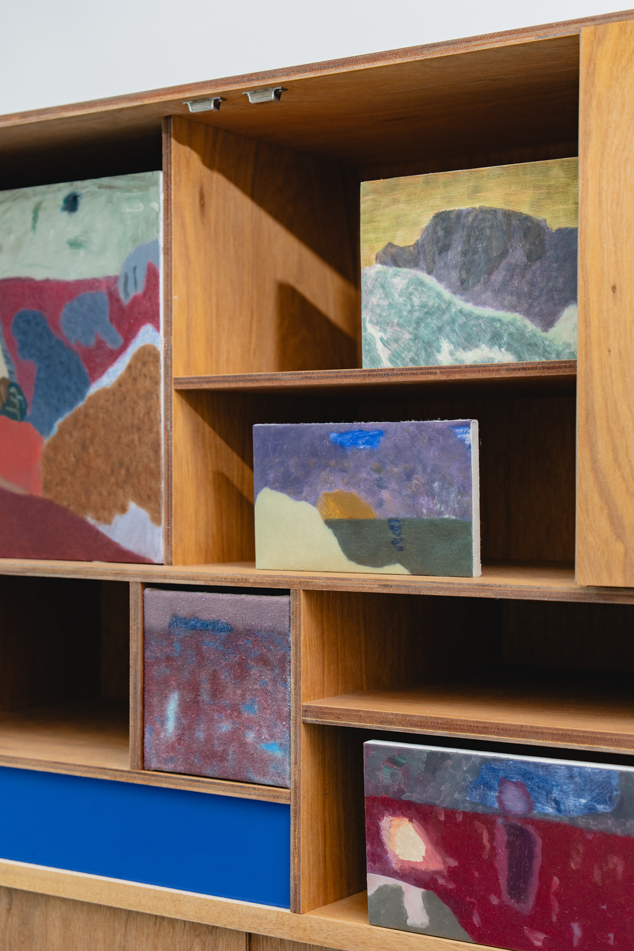







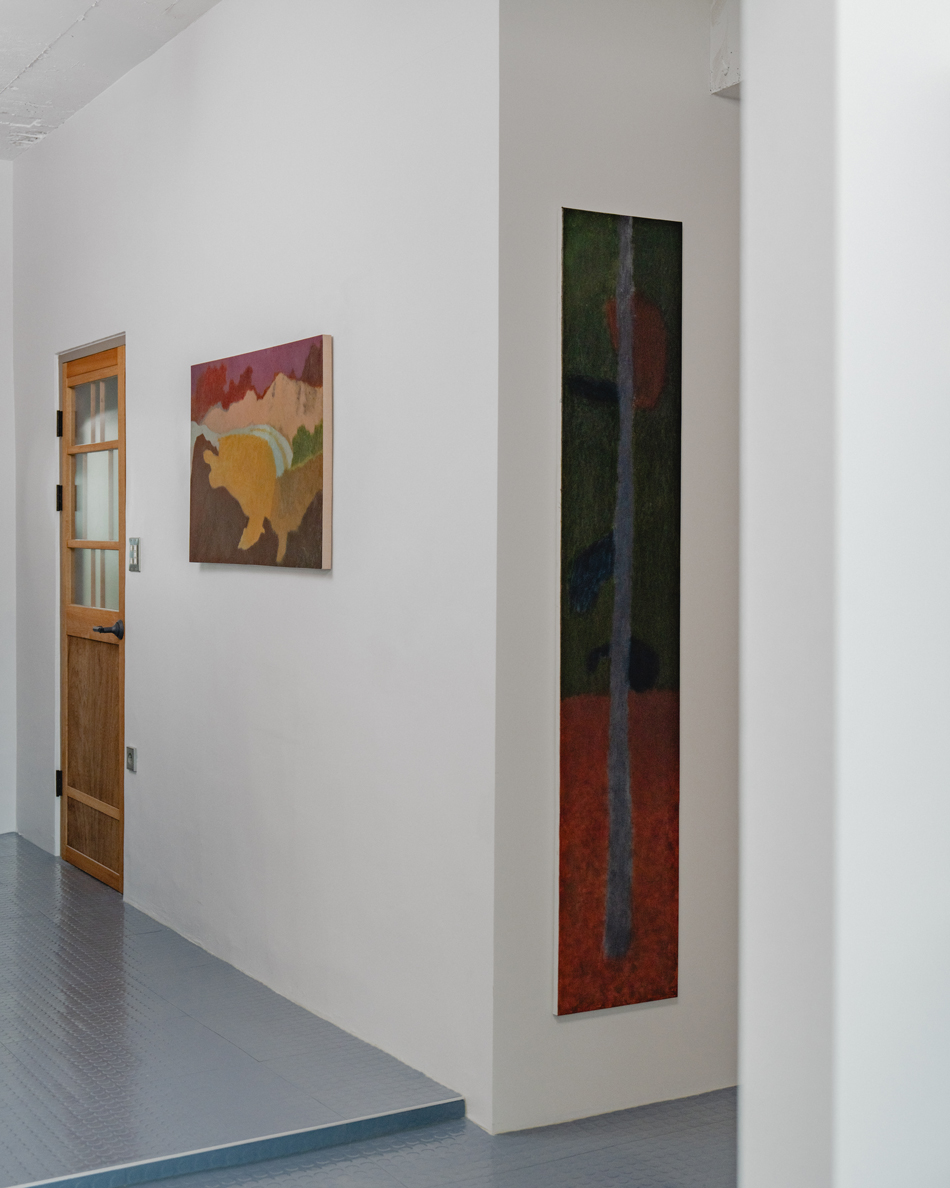
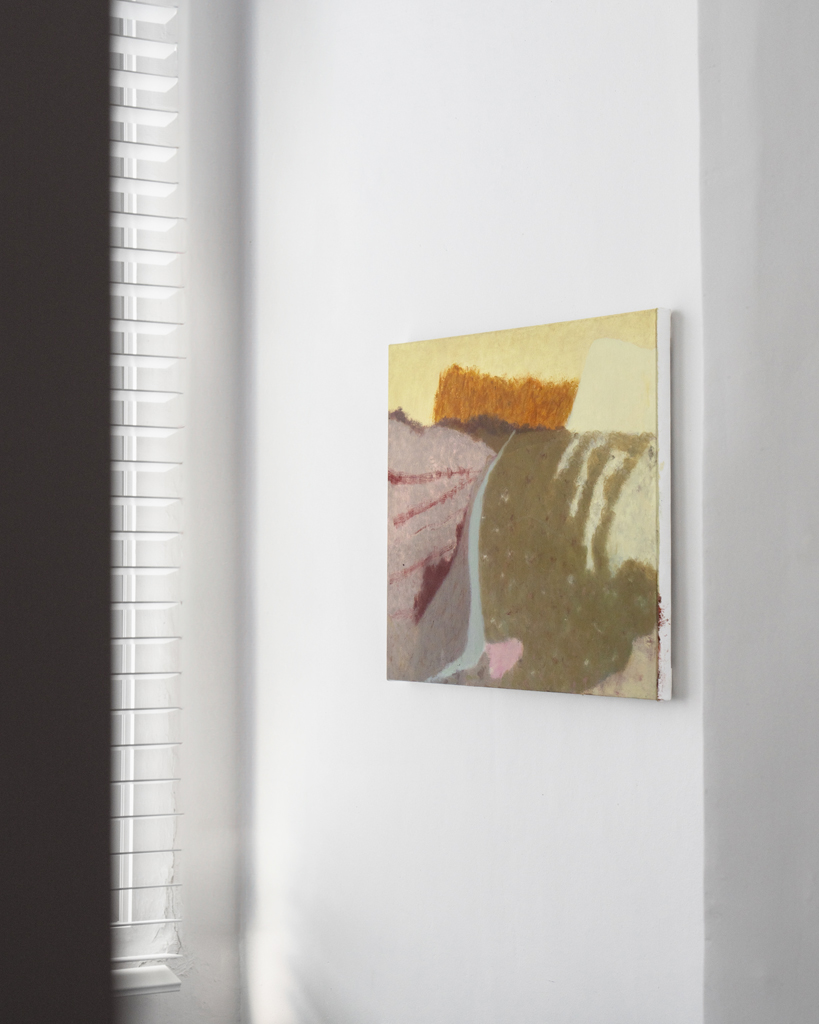
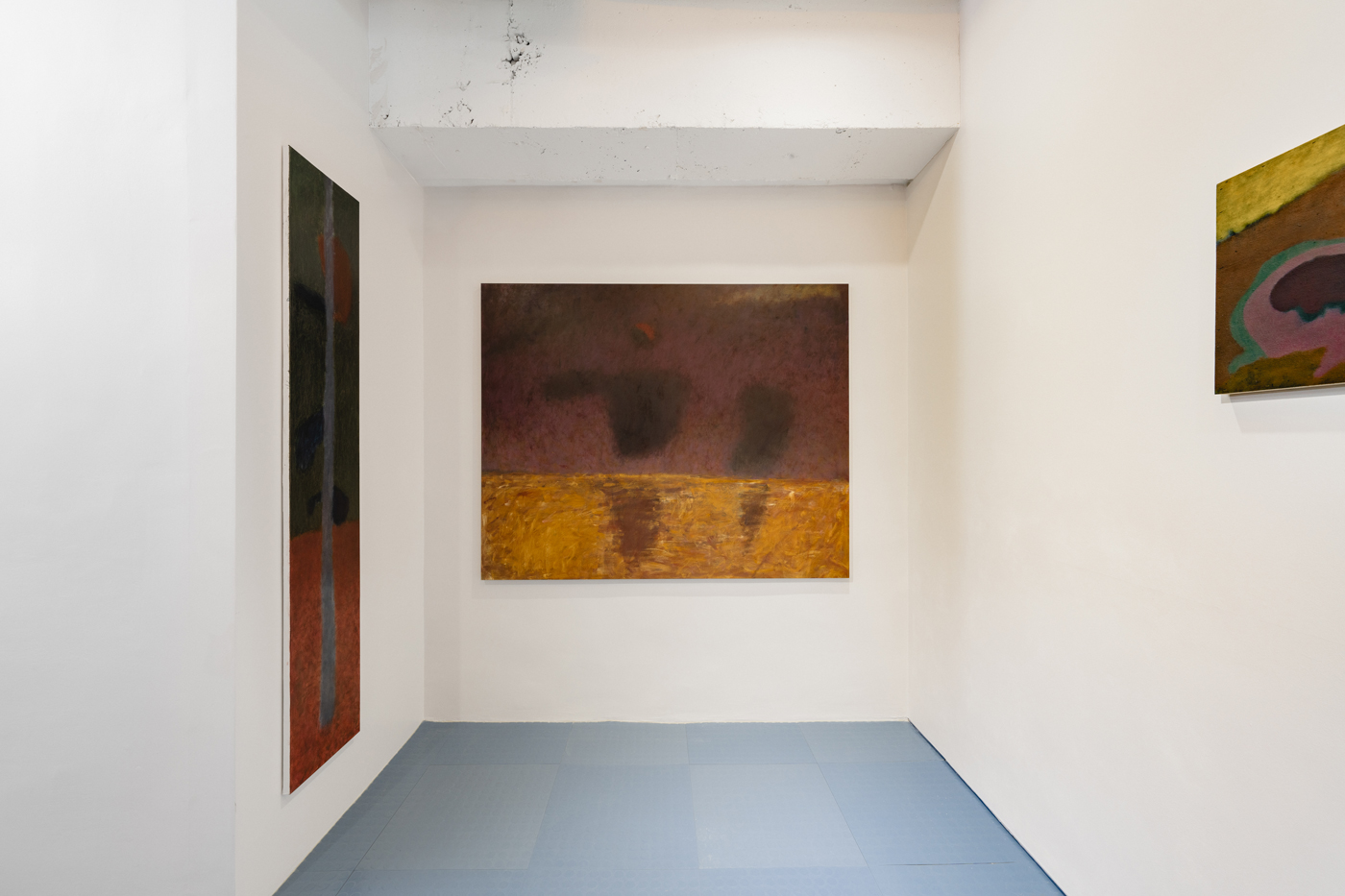

Artist’s Statement
떠올리려야 떠올릴 수 없는 날이 있다. 정확히 말하자면, 지금은 없는 대상과 사건이 너무나 선명하게 각인돼 오히려 그 선명함에 잡아먹힐까 두려운 마음에 떠올릴 수 없다. 감히 지우거나 감출 수 없는 날들이기 때문에 비스듬히 만나는 것으로 대신한다.
시린 눈으로 보기
정면 쪽으로 고개를 두고 시선은 옆으로 돌려서 주변 시로 장면을 본다. 공포 영화를 볼 때, 궁금하지만 제대로 보기엔 무서울 때 쓰는 방법과 비슷하다. 그러면, 눈이, 평소에 공기에 노출될 일이 드문 눈의 옆면이 세상을 본다. 가녀린 눈 표면은 금방 메마른다. 시린 눈은 자신을 보호하 고자 눈물로 막을 씌운다. 세상은 조금 더 흐려진다. 반대로 아주 뚫어져라 보기도 한다. 눈 싸움을 하듯 눈 돌리지 않고 있으면 초점을 놓쳐버린다. 뻑뻑한 눈은 결국 흐트러진다. 시린 눈으로 죽은 존재들이 있던 장면을 본다. 그들의 빈자리를 마주해 괴롭지만 선명하지 않아 감당할만하다. 떠올리되 완전히 떠올리진 않은 상태로, 부재를 느끼되 휘둘리진 않을 정도로, 그렇게 부재하는, 상실된, 이제 없는 과거의 것들과 함께 살아가는 법을 학습한다. 희부연한 장면은 색, 방향, 면적, 도형, 분위기, 뉘앙스 같은 굵직한 것만 남는다. 많은 디테일을 털어내고 식별을 위한 최소한의 조형적 요소만 있다. 이제부터는 그것으로 과거를 떠올리기로 한다. 마치 암호처럼 기능하며 대상을 은연중에 부른다. 알쏭달쏭 한 호출이며 몰래 불러내는 방법이다. 못 듣거나 눈치채지 못해도 이상하지 않을 만큼 느슨하게 말이다.
길게 늘어진 풍경 (Paysage allongé)
시린 눈으로 발견한 조형적 모양은 끈질기게 나를 따라온다. 뒤따라오던 것은 갑자기 먼저 나타나고 나를 앞서기도 한다. 나를 따라오는 것인지 내가 따라가는 것인지 구분하기 어렵다. 모양들을 그리지 않을 수 없었다. 기다렸다는 듯이 캔버스에 안착하며, 모양은 제 모습을 굳건히 지키기도 속절없이 변하기도 한다. 과거의 도형은 화면의 구도, 색, 충동적 붓질, 순간적인 선택으로 인해 다르게 그려진다. 할아버지의 니트에서 발견한 자주색, 붉은색, 파란색의 색 조합은 이리저리 그려지며 바닷가나 나무가 된다. 가을에 죽은 고양이의 무늬는 구름이나 수풀이 되고, 오래전 개의 말린 등은 곡선으로 남아 산등성이, 섬의 외곽선, 길의 경로로 그려진다. 모양이 숨은 뒤에는 풍경이 자리한다. 대상과 사건을 도려내고, 그 주변을 이루고 떠받치고 있는 바탕인 풍경을 그리고자 했다. 꼭 나의 할아버지, 고양이, 개, 친구가 아닌 누구든 들어올 수 있는 곳이 되기를 바랬다. 풍경은 과거에 기대 그려졌지만 지금 여기에 있는, 그렇지만 현재는 아닌 현재의 부록과 같은 시간을 가진다. 선형적인 시간을 휘저어 뭉쳐버린 풍경은 여기저기 옮겨 다닌다. 과거에 뿌리를 두고 현재에 있을 법 한, 어쩌면 나중에 볼 곳과 닮은 풍경이다. 프랑스에서는 미국식의 아메리카노를 Café allongé라고 한다. allongé는 늘이다, 연장하다, 길어 보이게 하다는 뜻의 동사 allonger의 형용 사로, 에스프레소 샷에 물을 넣어 커피를 늘렸다는 뜻이다. 풍경들은 끝난 과거의 장면에 물을 잔뜩 쏟아 길게 늘어트린 것이기에 Paysage allongé라 불릴 만하다. 연하게 탄 과거는 은근하게 암시되며 현재에 스민다. 내일 아침에도 흐릿한 과거 향이 날 것이다.
Q&A with Hye Jin Yoon
Q: 이번에 작가님의 화풍에서 달라진 점이 보이는데요, 과거 더 정제된 붓 터치에서 현재 더 거칠고 다듬어지지 않은 붓 터치가 느껴집니다. 달라지게 된 계기가 있으신가요?
A: 큰 분기점은 작년 4월부터 그리기 시작한 수채화 드로잉입니다. 보통 작업에 바로 들어가는 편이었고, 드로잉을 하더라도 간단한 선 몇 개로 이루어진 라인 드로잉만 해왔습니다. 수채화를 사용하게 된 계기는 할아버지의 니트가 의자에 아무렇게나 걸린 장면을 그리기 위함이었어요. 짙은 남색과 파란색 면 사이로 빨간색 줄이 한 줄 껴있는 패턴이 반복되는 옷이었는데 의자에 걸쳐져 이리저리 구불거리고 있었어요. 붉은 선들과 굽은 남색이 파도치는 풍경과 나무들로 보였어요. 아주 잠깐 비친 인상이라 가볍고 빠르게 그리고 싶어서 수채화를 택했습니다. 할아버지의 니트 드로잉 이후로도 계속 수채화 드로잉을 하고 있습니다. 상대적으로 간편한 수채화는 마음에 남은 대상과 장면들을 덜 추려내고 그리도록 해줬습니다. 더 다양하고 가까운, 신변잡기적 장면들을 모티브로 그리기 시작했어요. 조형적이지 않은 장면에서 크고 작은 조형적 요소를 발견해 충동과 조율을 반복하며 작업할 수 있었습니다.
제 작업은 과정 중에 많이 바뀌는 편이에요. 저는 수성 재료는 거의 쓰지 않았고 유화만 사용해왔기 때문에 느리게 건조돼 수정이 용이한 유화의 어법에 익숙한 상황이었어요. 10년 만에 쓰는 수채화는 제가 생각한 것보다 금방 건조됐어요. 이미 칠한 색, 형상, 구도를 바꾸기 위해서는 수채 물감을 두껍게 묻혀 찍어 누르듯이 올려야 했어요. 화면을 세심하게 훑는 부드러운 붓보다는 모양 잡힌 힘 있는 붓으로 바꾸게 되었고, 스미듯이 그리기보다는 짧은 터치를 여러 번 두드리듯이 칠하게 되었습니다. 두껍고 짧은 겹겹의 붓 터치들이 동시에 보이며 만들어지는 색, 물기 없이 갈라지는 붓질 등 수채화에서 생긴 어법은 자연스레 유화 작업에도 영향을 줬습니다.
Q: 작가님의 작품에서만 찾아볼 수 있는 색감의 특징이 있는 것 같습니다. 빛이 바랜 듯한 색감과 듬성듬성 심겨 있는 채도 높은 대상들이 공허하기도, 또 반대로 희망적인 느낌이 동시에 듭니다. 색을 고르실 때 고려하는 것들이 있으신가요?
A: 저는 없는 대상과 그를 둘러싼 주변, 사물이 담긴 장면에서 발견한 요소로 작업을 시작합니다. 앞서 말씀드렸던 것처럼, 최근에는 덜 정제된 장면들까지 작업에 포함시키고 있는데요, 그 이유 중 하나가 다양한 색을 쓰고 싶어서 입니다. 선별하지 않은 장면에는 무분별한 색들이 마구 끼어 있거든요. 예를 들면 핫 핑크색, 축축한 늪 색, 아주 샛노랗거나 빨간색 등은 기존에는 잘 쓰지 않던 색이에요. 선택하는 장면이 폭이 넓어짐에 따라 제가 영감을 얻는 색이 더 많아졌어요.
장면에서 작업을 시작하는 색의 힌트를 얻고, 그 후로는 조형적인 판단으로 색을 선택합니다. 이 과정에서 기존의 메인 컬러들이 과감히 없어지기도 하고, 완전히 다른 조합이 되기도 해요. 보통은 손이 앞서서 색을 선택하고 저는 색깔이 선택되는 것을 보는 관망자 같은 입장인데, 어떨 때는 어떤 선택도 하지 못하고 주저할 때가 있어요. 그럴 때 저는 이 부분에 절대 쓸 것 같지 않은 색을 선택하려 해요. 진퇴양난에 빠졌을 때 조커 카드처럼 믿고 맡기는 색이 아닌 색깔이요. 물론 그 후엔 전체적인 조화를 위해 덮기도 하지만.. 충동과 객기를 번갈아 쓰며 물감을 골라요. 그래서 예전에 비해 사용하는 색들이 달라졌다고 느껴요. 아주 채도 높은 색도 심심찮게 등장하고, 노란색과 보라색, 적갈색 등은 별로 좋아하지 않았는데 이번 전시에서는 메인 컬러들이 되었어요.
더 자세히 말씀드리자면, 이번 작업 들에서 적보라색이 특히 많이 쓰인 이유는 할아버지께서 자주 입으시던 상의의 색깔이기 때문입니다. 할아버지께서 돌아가신 후에 사촌 동생과 할아버지의 체취가 남아있는 니트를 한 벌씩 나눠가졌어요. 1번 질문에서 언급했던 짙은 남색과 파란색에 빨간색 줄이 있는 니트는 사촌 동생이, 나머지 하나는 적보라색과 검정 줄이 있는 니트로 제가 가져왔어요. 그 적보라 빛은 3년째 저를 따라다니고 있어요. 아주 커다란 화면에 적보라 빛이 압도하듯 코앞에 들이닥친 화면을 그리고 싶은데 아직 그리지 못했거든요. 그 적보라 빛의 조각들이 근래의 작업에 조금씩 등장하고 있다고 느꼈습니다.
Q: 작가님의 풍경 속에는 길이 자주 등장하는 것 같습니다. (이것은 누군가를 떠나보내는 길이 될 수도 있을 것 같고 헤어짐을 뒤로하고 걸어가야 할 길로 보이기도 합니다.) 길이 자주 등장하는 이유가 있을까요?
A: 원체 풍경을 좋아하기도 하고, 원하는 구도를 자유자재로 그려내기 위해 풍경을 많이 봐두고 그려왔습니다. 점차 현실 풍경을 볼 때도 작업에서의 보기 방식으로 보게 되었습니다. 소중한 지난 장면을 여러 번 꺼내 보고, 계속 보다 보니 특정 부분만 남고, 그곳에서 어떤 모양을 발견하고, 그 모양으로 그날을 기억하는 방식이요. 풍경에서 자주 나타나는 모양은 한쪽으로 휜 삼각형, 위아래가 뾰족하게 모아진 타원, 그리고 구불구불한 곡선입니다. 불시에 만나는 장면들을 그리게 되는데, 당연하게도 그곳엔 거기까지 도달하기 위해 걸어온 길이 있습니다. 앞으로 걸음을 이어가든 이어가지 않든 항상 연결된 길이 보였습니다. 휜 삼각형과 뾰족한 타원은 길이 언덕을 끼고 빙 돌아가며 좁아지는 모양에 뿌리를 둡니다. 곡선은 멀리서 더 먼 곳으로 뻗어가는 길에서 따왔어요. 길처럼 그려진 곡선은 가을에 죽은 고양이와 오래전 두 개들의 마지막 모습인 굽은 등을 암시하기도 합니다. 어쩌면 곡선에 대한 애정 때문에 유독 길이 크게 보였을 수도 있겠네요.
길은 제가 보는 풍경에서 없어지지 않고, 없어질 수 없는 요소입니다. 그것이 있어야 풍경을 만날 수 있는 필수적인 것으로 웜홀과 닮았다고 생각했습니다. 언제든 다시 이곳으로 돌아올 수 있게 허락하며 시간의 흐름과 관계없이 그곳이 존재하도록 떠받쳐주는 점에서요. 제가 모양을 통해 지난 장면으로 언제든 돌아갔다 다시 다른 모양으로, 다른 시간으로 이동하는 것과도 닮았어요.
자꾸 따라오며 앞뒤로 이어지는 길은 이곳이 결코 점으로 끝나지 않는다는 것을 상기시키고 확인시켜줍니다. 한 장면이 그저 장면으로 끝나지 않고 여기저기서 출몰하고 다시 나타나는 것을 바라는 제 마음을 응원하는 것 같기도 합니다.
Q: 작가님의 작품은 대부분 가로 풍경인데요, 이번 전시에서는 아주 긴 작품 <타워(Tower)>가 눈에 띕니다. 어디서 영감을 받으셨는지, 또 제작하시게 된 이야기가 궁금합니다.
A: <타워>는 가능한 한 긴 캔버스에 그리려 한 작업입니다. 앞선 답변들에서 언급한 가을에 죽은 고양이의 이름은 나비인데요, 몇 살인지 모른 채 나타나 6년을 조금 넘게 함께 살다가 홀연히 가버렸어요. 나비가 죽은 지 거의 반년이 흘렀지만 나비가 쓰던 캣타워가 그 자리에 그대로 있어요.
나비는 캣타워를 정말 좋아했는데, 그래서 타워에 올라가 있을 때는 굳이 만지거나 다가가지 않았어요. 게다가 다른 고양이는 절대 올라가지 않아서 오로지 나비만의 공간이었습니다. 나비가 없는 지금은 아무도 쓰지 않아요. 거실 베란다에 덩그러니 있는 좁고 긴 그 공간은 도려내진 것처럼 느껴졌어요. 천장까지 닿는 타워는 고개를 꺾어 올려다봐야 하고, 얇은 뼈대와 발판 사이의 공간이 더 광활하게 보였습니다. 나비와 지금의 나처럼 절대 거리를 좁힐 수 없음을 증명하듯 아주 멀게 떨어져 있어요. 아득한 타워의 끝과 그것을 쫓으며 느껴지는 무력감이 그려지길 바라며 길고 긴 화면을 선택했습니다. 캣타워임을 모르면 모른 채로 지나갈 수 있는, 알아보려면 알아볼 만한 힌트만 두고 그렸어요. 인지하지 못해도 좋고, 오히려 단번에 알아보지 못하길 바라고 있습니다. 작품 제목을 <타워>로 지은 것은 ‘타워’라는 단어의 거대함과 그 웅장함에 딸려 있는 무력감을 빌려오기 위함입니다. 죽음 이후의 시간, 결코 알 수도 가까워질 수도 없는 미지의 그것을 생각하면 영문도 모른 채 움츠러들던 기분과 비슷해요. 가을 이후 제대로 보지 않던 베란다 한켠을 <타워>를 통해 마주하고 있습니다.
Q: 포켓테일즈에서 2024년 첫 전시를 장식해 주셨는데요, 이번에 포켓테일즈에서 전시 기획을 하시면서 관람객들 에게 전해주고 싶으신 전시 관람 포인트가 있을까요?
A: <시린 눈의 옆면> 전시에 보이는 풍경들은 제 소중한 과거의 대상과 순간이 깃든 풍경도 있고 아닌 것도 있습니다. 잘 숨겨놓다가, 무엇을 모티브로 하는지 알아봐 주길 바라며 티 나는 힌트를 끼워 넣고, 아무것도 없이 조형적 재미만을 쫓아 그렸지만 절절한 사연이 있는 척하는 풍경을 두기도 했습니다.
작업을 보시는 분들께서 풍경이 어디서 왔을지 상상해 보신 후 어떤 것이 보이셨다면 그것과 비슷한 각자의 기억을 떠올려보시면 좋겠습니다. 반대로 어떠한 서사 없이 화면을, 색을, 공간을 느껴주셔도 좋을 것 같아요. 장면과 엮인 순간을 떠올리며 마음 시려 하다가도 물감과 붓, 색이 주는 즐거움에 완전히 까먹기도 하는 제 변덕처럼 명쾌하고 아리송하게 봐주시면 좋겠습니다.
Q: I've noticed a change in your painting style this time around. Your previous work had a more refined touch with smoother brushstrokes, while now, there's a noticeable shift towards rougher and less polished strokes. Is there anything that made you change?
A: The big turning point is the watercolor drawings that I started making in April of last year. I usually started working right away, and even when I did draw, I only did line drawings consisting of a few simple lines. The reason I started using watercolor was to draw a scene where my grandfather's knitwear was casually hanging on a chair. It was a garment with a repeating pattern of a red line between dark blue and blue cotton, and it was draped over a chair and was waving around. I saw red lines and curved dark blue waves as a landscape and trees. Since it was a very brief impression, I wanted to draw it lightly and quickly, so I chose watercolor. I have continued to do watercolor drawings since my grandfather's knit drawings. The relatively simple watercolor painting allowed me to draw less selectively the objects and scenes that remained in my mind. I started drawing more diverse, close, personal scenes as motifs. I was able to discover large and small formative elements in non-formative scenes and work through repeated impulses and coordination.
My work tends to change a lot during the process. Since I had rarely used water-based materials and had only used oil paintings, I was familiar with the method of oil painting, which dries slowly and is easy to modify. My first watercolor painting in 10 years dried faster than I expected. In order to change the color, shape, or composition that had already been painted, I had to apply a thick layer of watercolor paint and press it down. Instead of using a soft brush that carefully sweeps the canvas, I changed to a hard and tough shaped brush. Rather than drawing in a smooth stroke, I started painting with several short strokes. The language created in watercolor, such as colors created by thick and short layers and dry brush strokes, naturally influenced my oil painting works.
Q: Color in your work really stands out. The way you use muted shades alongside pops of vibrant color gives off this feeling of both emptiness and hopefulness at the same time. Can you tell us a bit about how you choose your colors?
A: Well, I usually start by looking at scenes that include the object that no longer exists, and focus on elements that surround it. Lately, I've been using a wider range of scenes because I'm interested in exploring a wider range of colors. In these scenes, I've noticed a variety of unexpected colors. Colors like hot pink, murky greens, pale hues, and vivid reds, which I didn't utilize much in the past, now find their place in my work. As I've expanded the range of scenes I incorporate, I've found myself inspired by a wider array of colors.
I start with a color that sparks my interest in a particular scene, then I make color choices based on my artistic judgment. During this process, I might boldly eliminate existing main colors or opt for entirely different combinations. Usually it's almost like I'm just the observer as my hand instinctively selects the colors. However, there are times when I find myself hesitating. In those moments, I try to select a color that I wouldn't normally consider for that particular part of the artwork. I rely on colors that I wouldn't typically trust, unlike a joker card that solves dilemmas. While I'll later adjust them to ensure overall harmony... I choose my paints impulsively, sometimes daringly, alternating between instinct and inspiration. As a result, I've noticed a shift in the colors I use compared to before. Vibrant hues now make frequent appearances, and despite my previous aversion to yellow, purple, and reddish-brown, they've emerged as the main colors in this exhibition.
To explain further, the reason why shades of red-purple were particularly prevalent in this series of works is because they were the colors of the sweaters my grandfather often wore. After my grandfather passed away, my cousin and I each inherited a knit sweater that still carried his scent. The sweater with dark blue and blue hues, as mentioned earlier, was given to my cousin, while the other one with red-purple and black stripes, became mine. That red-purple light has been accompanying me for three years now. I've been longing to capture a scene where the overwhelming red-purple light fills a very large canvas right before my eyes, but I haven't had a chance to do it yet. However, I've noticed fragments of that red-purple light slowly making their way into my recent works.
Q: It appears that roads are a common feature in your landscape paintings. I want to hear more about these roads.
A: Well, I've always been drawn to landscapes and have spent a lot of time appreciating and sketching them to capture the compositions I want. Over time, I've started seeing real-life landscapes in a similar way to how I approach my artwork. I often revisit memories of special scenes, and with constant viewing, only certain details remain, inspiring me to discover shapes and use them to preserve those moments. In my landscapes, you often see shapes like slanted triangles, ovals with pointed ends, and winding curves. When I stumble upon unexpected scenes to paint, there's usually a path leading to them, whether I continue walking forward or not. These paths always seem to be there, connecting everything together. The slanted triangles and pointed ovals often represent hillsides, curving and narrowing as they wind along. As for the curves, they're drawn from roads that stretch into the distance. Sometimes, these curves symbolize poignant moments, like the last sight of a cat in autumn or the final meeting of two old friends. Perhaps my fondness for curves is why roads stand out so prominently in my work.
A road is a constant presence in the landscapes I observe, an essential element that cannot be left out. I thought it resembled a wormhole, allowing me to return to this place at any time, regardless of the passage of time. It upholds the existence of that place, allowing me to revisit past scenes through shapes, transitioning into different forms and timeframes. The road, persistently guiding and connecting past and present, serves as a reminder that this place extends infinitely rather than concluding as a mere point. It seems to support my desire for scenes to not just end as scenes, but to reappear here and there.
Q: Most of your paintings are horizontal landscapes, but in this exhibition, a very long piece titled <Tower> stands out. I'm curious about where you drew inspiration from and the story behind its creation.
A: The <Tower> is a work intended to be drawn on the longest canvas possible. The cat's name, Nabi(meaning butterfly in Korean), mentioned in previous answers, lived with me for over six years, suddenly passing away without us knowing her exact age. Even though it's been almost half a year since Nabi passed, her cat tower remains in the same spot where it used to be. Nabi really loved her cat tower, so when she was up there, we didn’t bother to touch or approach her. Moreover, no other cat would ever climb it, making it exclusively Nabi's space.
Now that Nabi is gone, no one uses it anymore. The narrow and long space sitting alone on the living room veranda felt like it had been left deserted. I had to stretch my neck to look upwards to look at the tower reaching up to the ceiling, and the space between the thin frame and the bottom plate appeared even more vast. It stood far away, as if to prove that there is no way to bridge the distance between Nabi and I. Hoping to capture the sense of helplessness felt while chasing after the distant end of the tower, I chose a long and elongated canvas. I painted it with only hints recognizable enough to notice, but obscure enough to pass by unnoticed. I titled the piece <Tower> to evoke the grandeur and overwhelming sense of powerlessness associated with the word. It's similar to the feeling of shrinking away without even understanding the unknown that comes after death, something that can never be fully grasped or approached. After autumn, I'm facing a corner of the veranda that I haven't really looked at properly through <Tower>.
Q: You opened up the first exhibition of 2024 at Pokettales. Do you have any exhibition highlights you'd like to share with the visitors?
A: In the exhibition <Brim of Misty Eyes>, you'll often encounter landscapes and pieces that carry moments from my precious past. I've hidden subtle hints, hoping visitors will uncover what serves as the motivation behind them. Some landscapes were crafted purely for artistic enjoyment, devoid of any backstory, but they may pretend to have a deeper story within them.
As you view my artworks, I encourage you to imagine where these landscapes might have originated and reminisce about your own memories that resemble them. Conversely, feel free to appreciate the scene, colors, and space without any narrative. Just as my mood swiftly shifts from pondering scenes and moments to getting completely lost in the joy of paint and brush, I hope you'll see my work as both clear and enigmatic.
Art Works

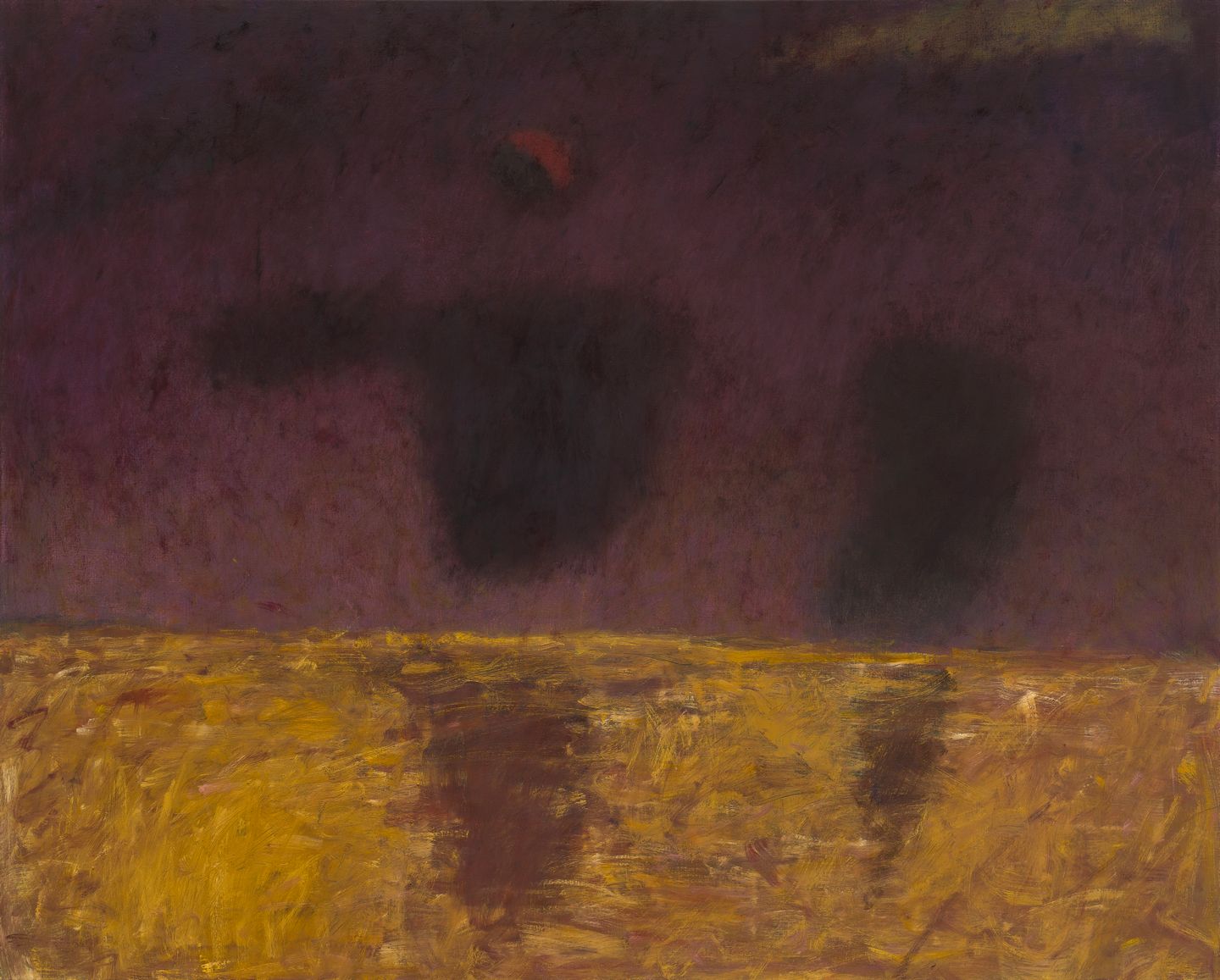

Sitting Afternoon
65 × 100 cm
린넨에 유화 Oil on linen
2024
65 × 100 cm
린넨에 유화 Oil on linen
2024
마주할 수 없는 것 (Speed of Time)
130 × 162.2 cm
캔버스에 유화 Oil on canvas
2024
130 × 162.2 cm
캔버스에 유화 Oil on canvas
2024
타워 (Tower)
182 × 33.5 cm
캔버스에 유화 Oil on canvas
2024
182 × 33.5 cm
캔버스에 유화 Oil on canvas
2024
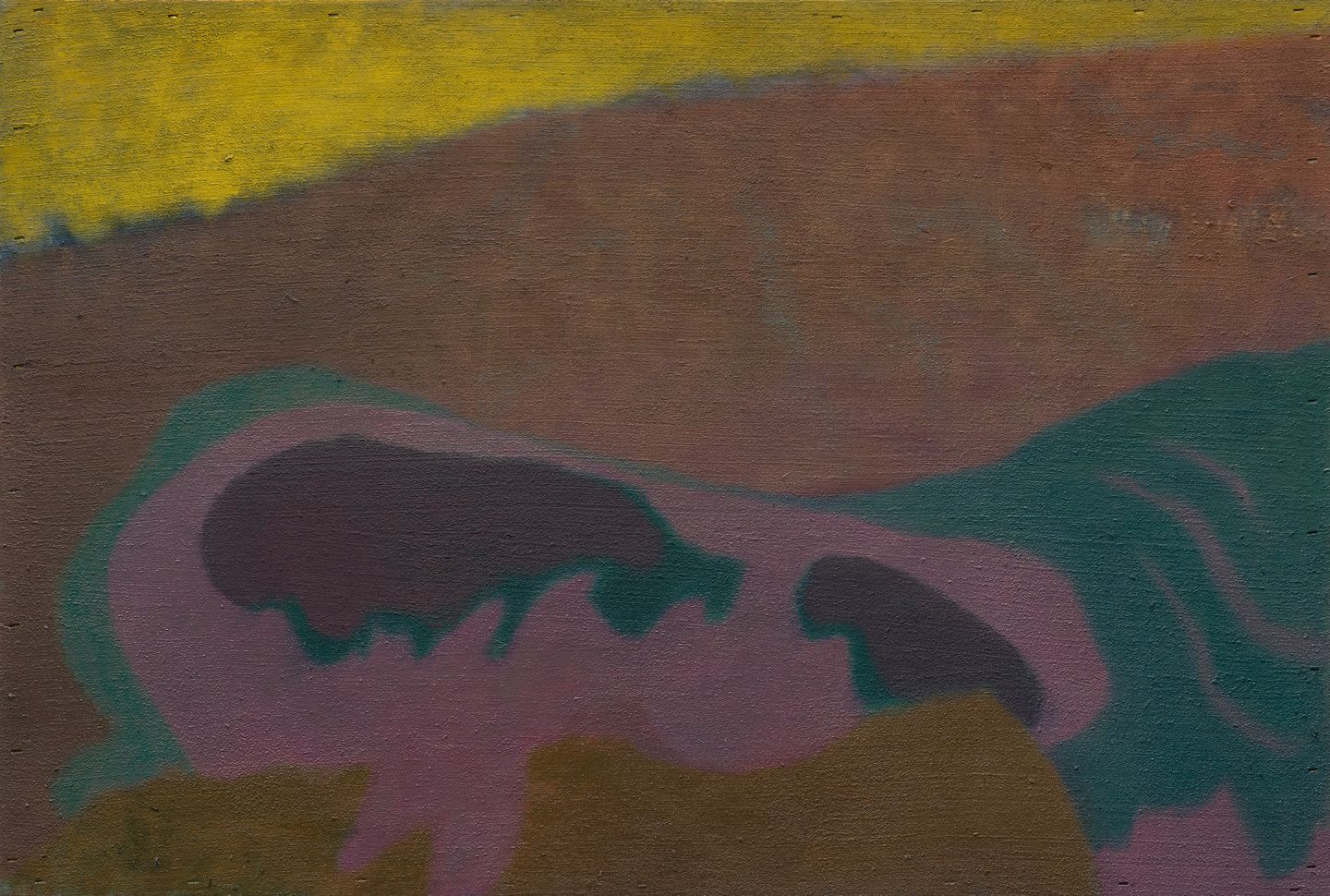


늘어진 풍경 (Paysage allongé)
41 × 60 cm
판넬에 유화 Oil on panel
2024
41 × 60 cm
판넬에 유화 Oil on panel
2024
Haunt
38 × 45.5 cm
캔버스에 유화 Oil on canvas
2024
38 × 45.5 cm
캔버스에 유화 Oil on canvas
2024
등 (Curve)
21 × 29.5 cm
종이에 수채 Watercolor on paper
2024
21 × 29.5 cm
종이에 수채 Watercolor on paper
2024
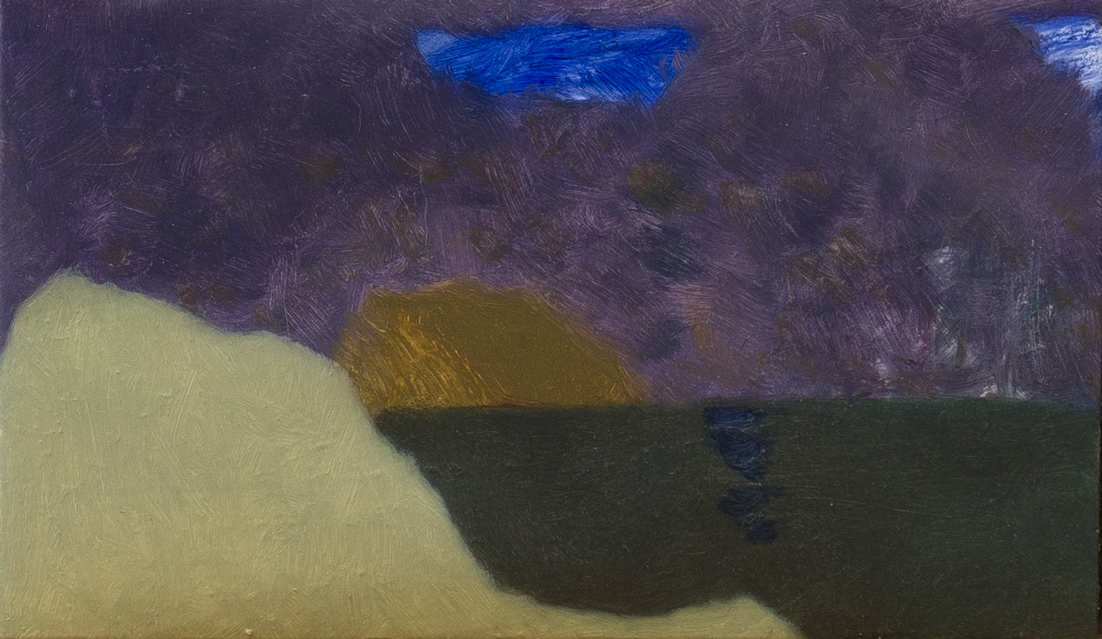

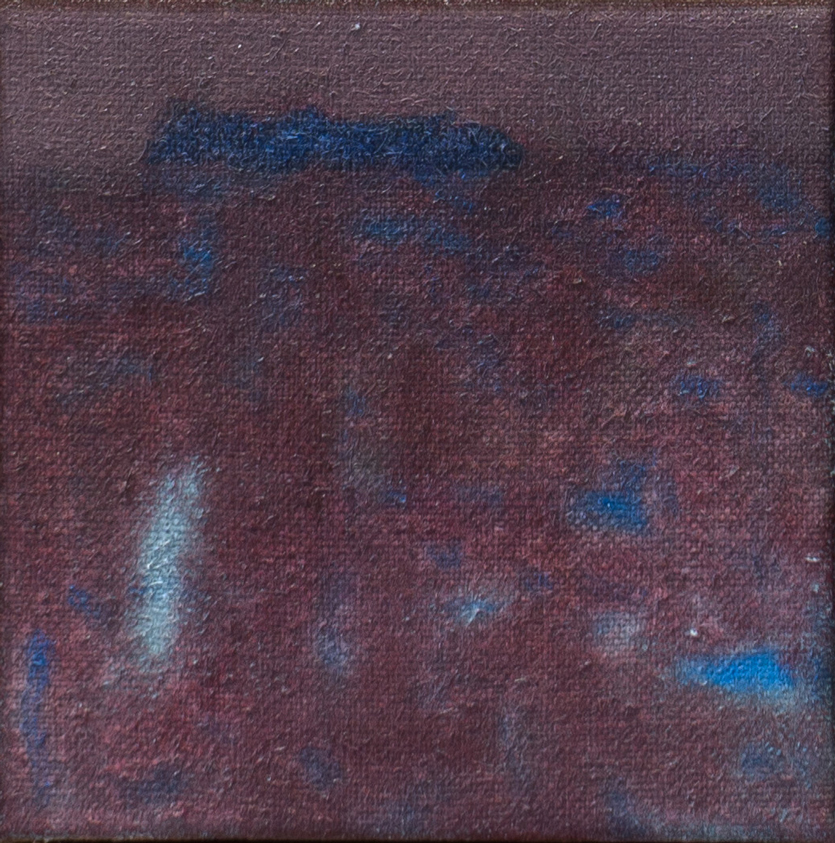
방해 (Normal Dawn)
16 × 27.3 cm
장지에 유화 Oil on paper(Jangi)
2024
16 × 27.3 cm
장지에 유화 Oil on paper(Jangi)
2024
니트와 졸업식 (Knit and Graduation)
19 × 33.4 cm
캔버스에 유화 Oil on canvas
2024
19 × 33.4 cm
캔버스에 유화 Oil on canvas
2024
Fond
21 × 21 cm
캔버스에 유화 Oil on canvas
2023
21 × 21 cm
캔버스에 유화 Oil on canvas
2023



Direction
45.5 × 60.6 cm
장지에 유화 Oil on paper(Jangi)
2024
45.5 × 60.6 cm
장지에 유화 Oil on paper(Jangi)
2024
거짓 작별 인사 (Fake Farewell)
53 × 80 cm
캔버스에 유화 Oil on canvas
2023
53 × 80 cm
캔버스에 유화 Oil on canvas
2023
새벽 식탁 (Table and Dawn)
33.4 × 77.2 cm
캔버스에 유화 Oil on canvas
2024
33.4 × 77.2 cm
캔버스에 유화 Oil on canvas
2024
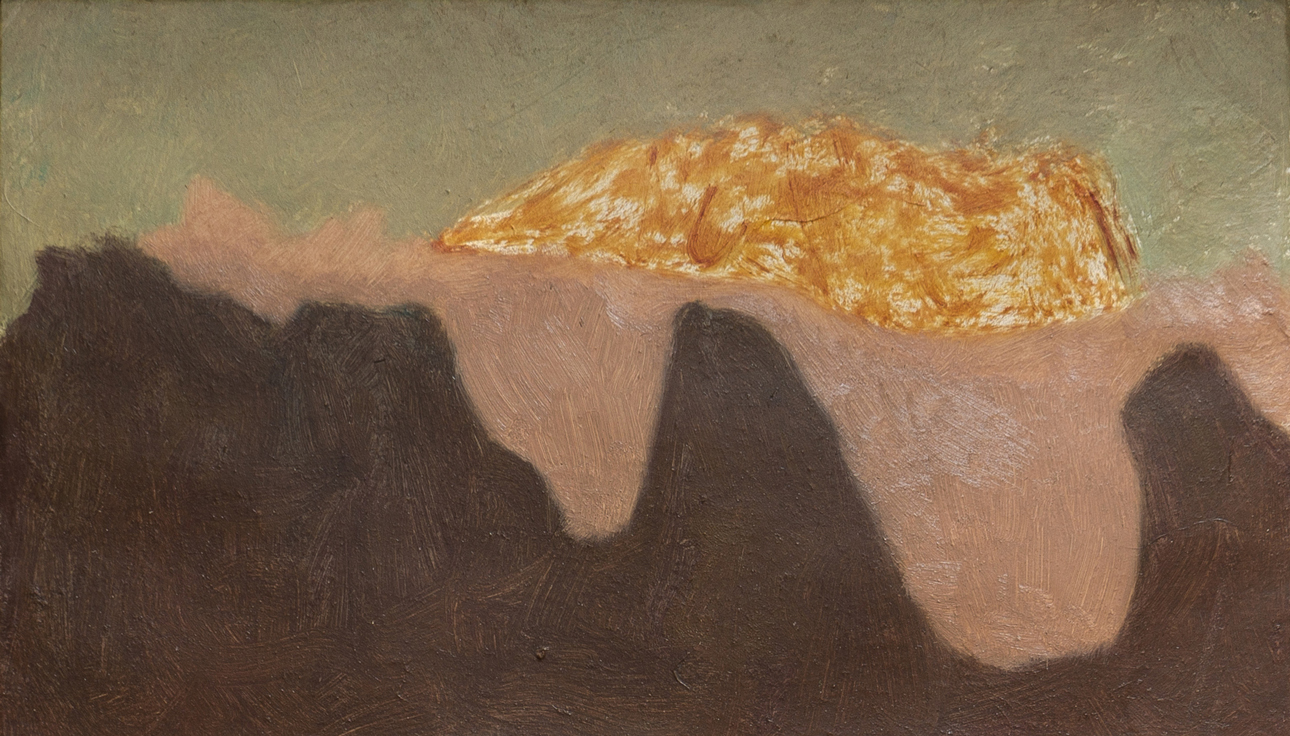


임시 약속 장소 (Temporary Rendezvous)
16 × 27.3 cm
장지에 유화 Oil on paper(Jangi)
2024
16 × 27.3 cm
장지에 유화 Oil on paper(Jangi)
2024
베란다와 손님 (Balcony Keeper)
62.5 × 47.5 cm
캔버스에 유화 Oil on canvas
2024
62.5 × 47.5 cm
캔버스에 유화 Oil on canvas
2024
Gaze 5
27.3 × 22 cm
캔버스에 유화 Oil on canvas
2023
27.3 × 22 cm
캔버스에 유화 Oil on canvas
2023

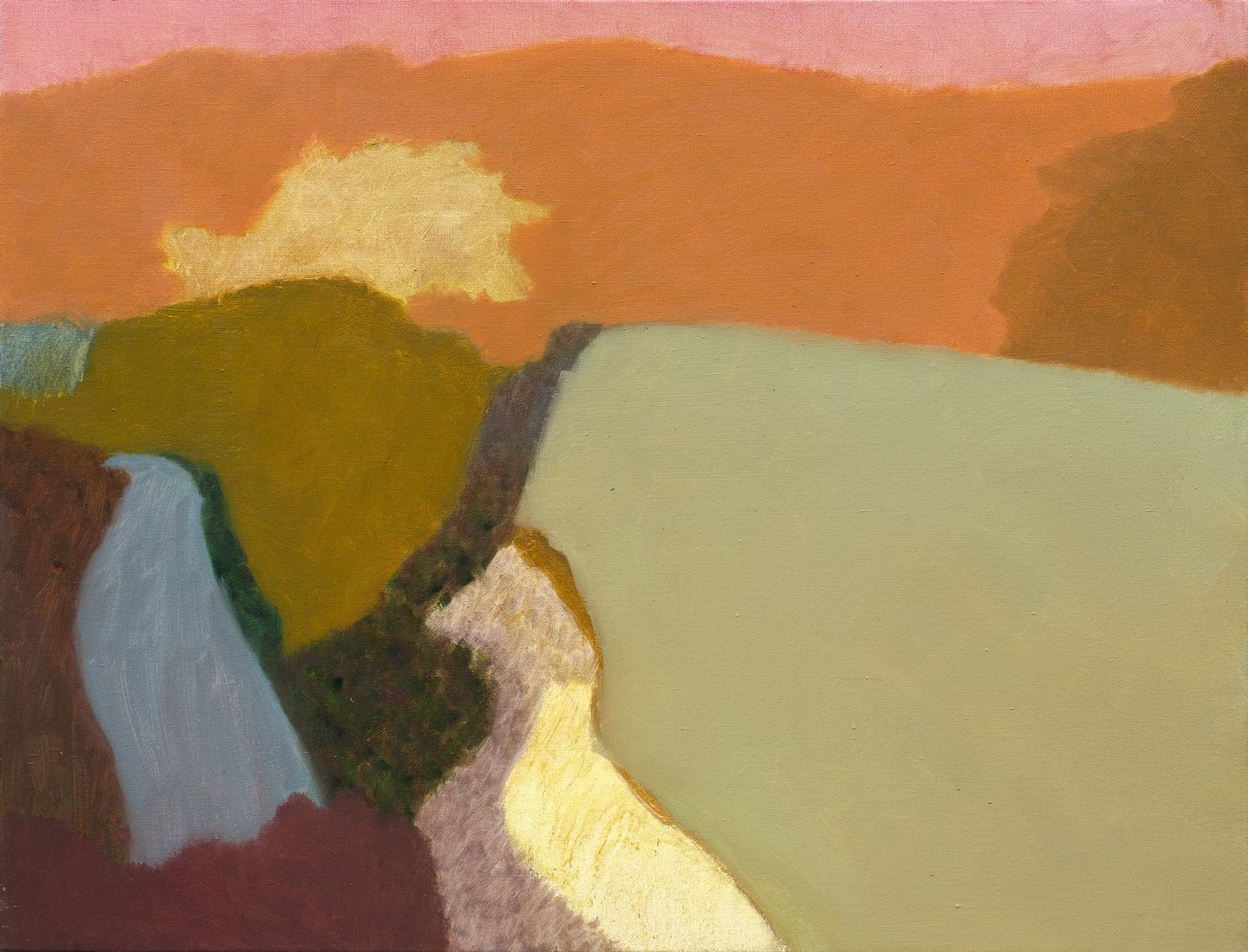
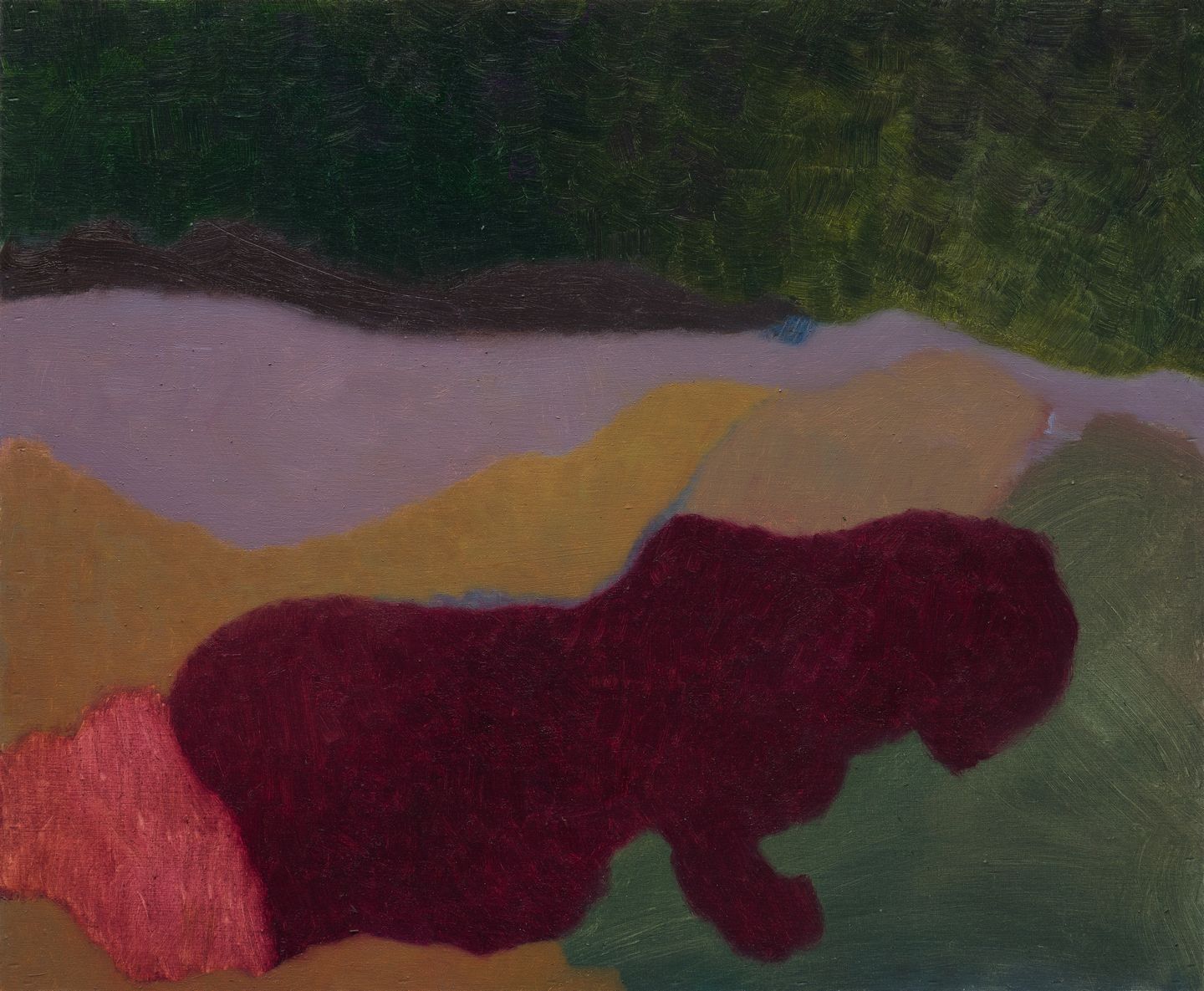
손님 맞이 (Noise and Splash)
41 × 53 cm
캔버스에 유화 Oil on canvas
2023
41 × 53 cm
캔버스에 유화 Oil on canvas
2023
산책길 (Promende)
50 × 65 cm
캔버스에 유화 Oil on canvas
2023
50 × 65 cm
캔버스에 유화 Oil on canvas
2023
급한 결정(Urgent Decision)
50 × 60 cm
판넬에 유화 Oil on panel
2024
50 × 60 cm
판넬에 유화 Oil on panel
2024

날의 앞 (Before the day)
50 × 60 cm
판넬에 유화 Oil on panel
2024
50 × 60 cm
판넬에 유화 Oil on panel
2024
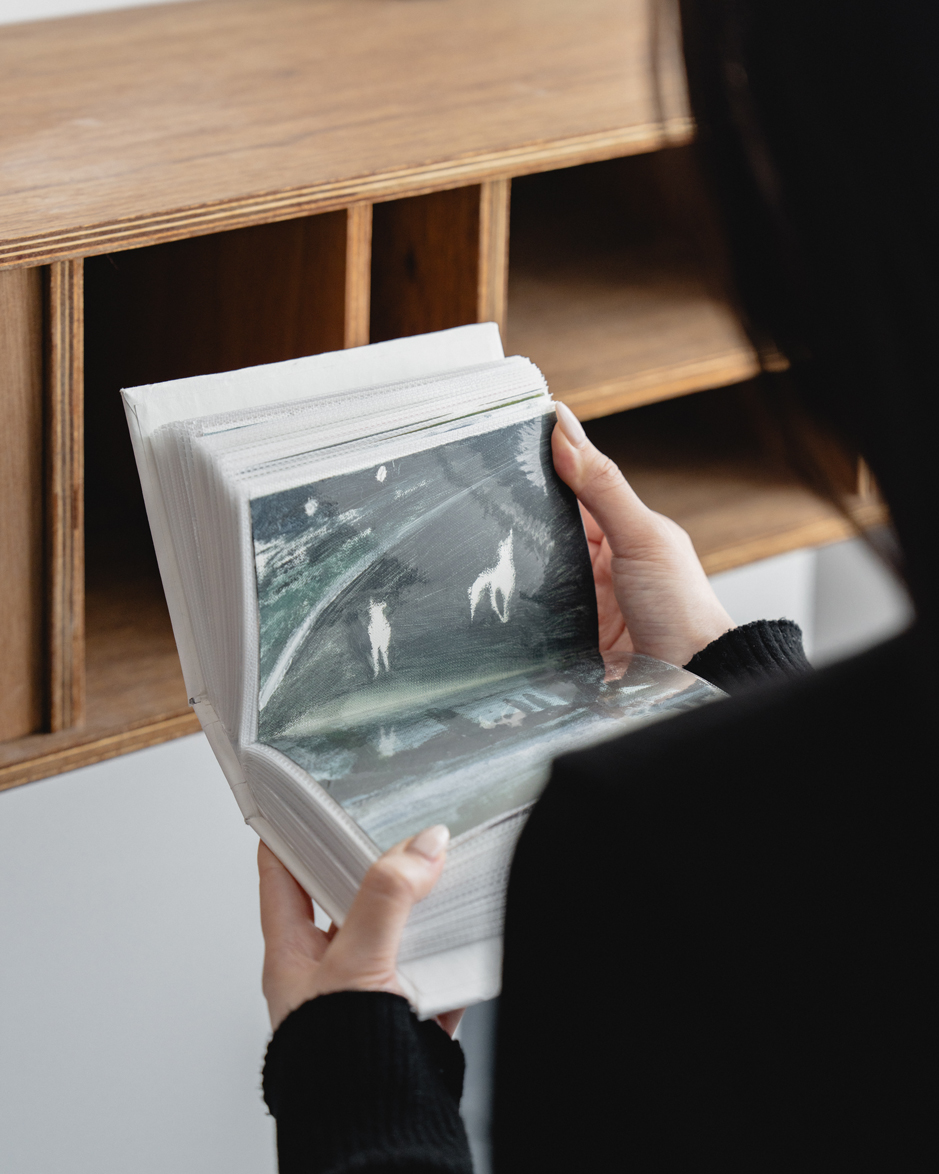
드로잉 모임 (Gathering Drawing)
각 10.5 × 15 cm
종이에 수용성 유화 Water soluble oil paint on paper
2022-2023
각 10.5 × 15 cm
종이에 수용성 유화 Water soluble oil paint on paper
2022-2023
Artist
윤혜진 (b.1994)
지금 없는 것을 어떻게 기억할것인지 고민한다. 과거의 대상과 사건이 담긴 장면에서 선, 색, 모양 등의 조형적 요소를 발견한다. 그것을 바탕으로 과거를 암시하지만 과거와는 다른, 현재 새롭게 작동하는 장면을 그린다. 대상과 사건은 숨고, 풍경은 우연한 만남과 충동적 선택, 조형적 판단으로 그려진다. 회화적 풍경이 선형적인 타임라인을 뒤섞은 채 여기저기 출몰하기를 기대한다.
Hyejin Yoon (b.1994)
I find myself contemplating how to recall what no longer exists. Through this, I uncover formative elements like lines, colors, and shapes within scenes that hold remnants of past objects and events. These elements come together to depict scenes that evoke glimpses of the past, yet they diverge as I paint them in a fresh manner, operating within the present. Objects and events remain concealed, while landscapes emerge through serendipitous encounters, spontaneous choices, and formative interpretations. I expect that pictorial landscapes will sporadically manifest, intertwining with the linear timeline.
학력
2018 홍익대학교 미술학사 회화과 졸업 / 문학사 불어불문학과 졸업
2021~ 한국예술종합학교 평면조형 전문사 재학
개인전
2023 척추와 손등과 드라이브, 갤러리 인, 서울
Gaze and Haze, Light Little Walk, 서울
2019 Art & Artist, 에이앤에이갤러리, 서울
단체전
2024 Cuppy, ARC1, 서울
2023 음-파, 별관, 서울
더프리뷰 성수 with 신한카드, 성수 에스팩토리, 서울
2022 작은동물그림, 갤러리175, 서울
BGA INDEX : OPEN STORAGE, BGA인덱스, 서울
Waiting room, 수치, 서울
2018 컨슈머맛 팝콘, 임시공간 세네네, 서울
잔구름 지점, 돌창고 대정, 남해
경남 융복합 아트전, 통영
동그라미 아래 일광욕, 돌창고 시문, 남해
2016 기억을 기록하다, 오르다 살롱, 서울
레지던시
2018 돌창고 프로젝트 레지던스, 남해
Education
2018 BFA Painting, Hongik University, Seoul, Korea
BA French Language and Literature, Hongik University, Seoul, Korea
2021 ̃ MFA Painting, School of Visual Arts Korea national University of Arts, Seoul, Korea
Exhibition
- Solo
2023 Backbone, Curved hand, and the Drive, Gallery IN, Seoul
Gaze and Haze, Light Little Walk, Seoul
2019 Art & Artist, ANA Gallery, Seoul
- Group
2024 Cuppy, ARC1, Seoul
2023 Sound Wave, Outhouse, Seoul
The Preview Seong-su with Shinhan card, S factory, Seoul
2022 Small Animal Painting, Gallery 175, Seoul
BGA INDEX : OPEN STORAGE, BGA Index, Seoul
Waiting Room, Suchi, Seoul
2018 Consumer-flavored Popcorn, Temporary Space Senene, Seoul
Fine Cloud Point, Dolchanggo Daejeong, Namhae
Gyeongnam Convergence Art Exhibition, Tongyeong
Sunbath Under A Circle, Dolchanggo Si-moon, Namhae
2016 Record Memory, Orda Salon, Seoul
Residency
2018 Dolchango Project, Namhae, Korea
◻︎ Artist: 윤혜진 Hyejin Yoon @cn__n
◻︎ Photography : 고정균 Jungkyun Goh / 박성재 Sungjae Park
◻︎ Text: 김채송 Chaesong Kim_pokettales director
◻︎ Q&A: 정나라 Nara Jung_pokettales curator / 윤혜진 Hyejin Yoon
© 2024. YOON HYE JIN. All rights reserved.
